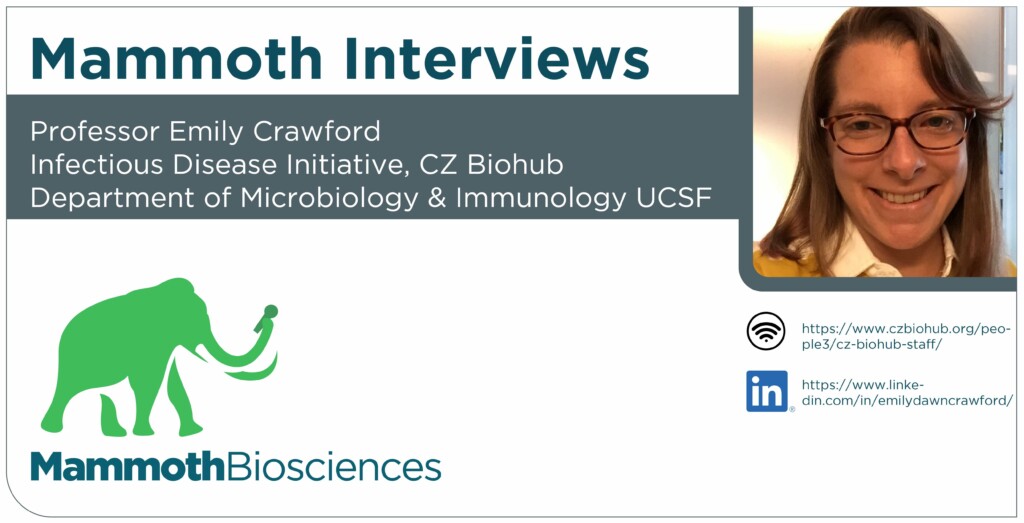Tyler Ford
01/15/2020
We regularly invite scientists to present their research to the Mammoth team. This facilitates collaborations and expands our knowledge of important topics including CRISPR, genome editing, diagnostics, and more. Rather than keep what we learn to ourselves, we’ve decided to share it with you through our Mammoth interviews series. This series features short Q&As with the many interesting scientists who speak at Mammoth. Get ready for some fascinating science and even more fascinating people!
In this post, we feature Professor Emily Crawford from UCSF and the CZ Biohub.

How did you end up at the CZ Biohub and what is it like to work there?
I joined the Biohub when it first started in late 2016. I previously worked as a postdoc in Joe DeRisi’s lab. It was there that I first started working on CRISPR-based diagnostic technologies. The Biohub hired me to expand on that work, and also to make CRISPR diagnostic technologies more accessible to scientists who could benefit from them, both locally and globally.
The Chan Zuckerberg Biohub is a great place to work. Our goals are similar to a biomedical science department in an academic institution, but operationally we are more like a small, agile biotech startup. Our primary mission is to cure, prevent or manage all known diseases, and we think the best way to do that is with open science and a focus on building interdisciplinary collaborations. The best things that happen at the Biohub usually involve biologists, engineers, data scientists and clinicians all getting together to tackle important problems. The Biohub is small – about 120 employees – but our role as a “hub” connecting three major Bay Area research institutions (UCSF, UC Berkeley and Stanford) gives us access to tremendous scientific resources.
What are your broad research interests and what drives your work?
I’ve been committed to infectious disease research since starting my postdoctoral work on malaria in 2014. Because of the incredible diversity of the microbial world and the countless ways that we interact with our environment, it’s an area that never gets boring. In fact, infectious disease scientists regularly get to observe evolution in action, which is always fascinating. You see viruses mutate to evade the immune system, and bacteria adapt to resist the antibiotics we treat them with.
Of course, infectious disease research is also an area where there’s enormous potential to impact human health. Everybody on the planet has experienced infectious diseases, and everybody is at some risk of having their life transformed by a future serious infection.
At the Biohub, my work focuses mainly on diagnostic methods. I ask questions like:
- How do you find the microbial culprit of a particular disease?
- How do you measure it?
- How do you understand its spread?
- How do you screen for it in time to provide appropriate treatment?
Current DNA and RNA sequencing-based tests combine to form something like a giant, slow, early version of a Star Trek-style tricorder. These fictional handheld devices can pinpoint the cause of a patient’s ailment after a few waves over the body. Our current tests use the universal language of DNA to tell us everything that’s present in a clinical sample. Being part of the evolution from these tests to their future smaller and faster counterparts is very exciting.
Why do you think it’s particularly important to develop new tools to fight infectious disease?
Because global infectious disease burden is so high, modest improvements in infectious disease diagnostics and treatments can have an outsized impact on the world. Although nothing in history has improved human health more than germ theory (which led to better sanitary practices as well as the development of antimicrobial drugs), infectious diseases are still three of the top ten global causes of death. We have the ability to diminish and even eradicate some of these diseases, but there’s still a lot of work to be done.
What is CRISPR’s role in the fight against infectious disease?
Great question. I think CRISPR technology has a very important role to play in infectious disease diagnostics, a role that’s only now becoming fully appreciated. The fundamental value of CRISPR is its ability to find particular DNA sequences in a programmable manner. When you apply it in a careful and sophisticated way, the effect can be like doing a Google search instead of reading the whole entire internet (which is what you’re sometimes doing when you perform next generation sequencing on a clinical sample). Depending on what you search for, you can learn about the presence and intensity of an infection, about susceptibility or resistance to antimicrobial drugs, and about a patient’s response to treatment. The work that CRISPR scientists are doing to make CRISPR diagnostic tools more effective is a big step towards that tricorder diagnostic future. These tools will have some of their greatest impacts on infectious disease.
Incidentally, I think CRISPR has a huge future in the treatment of infectious diseases as well. CRISPR systems evolved to be sophisticated players in the world’s vast microbe-vs-microbe arsenal. That’s also where many of our antibiotics come from. Stay tuned to CRISPR biologists to see what else these enzymes are going to be able to do for us in the future.
